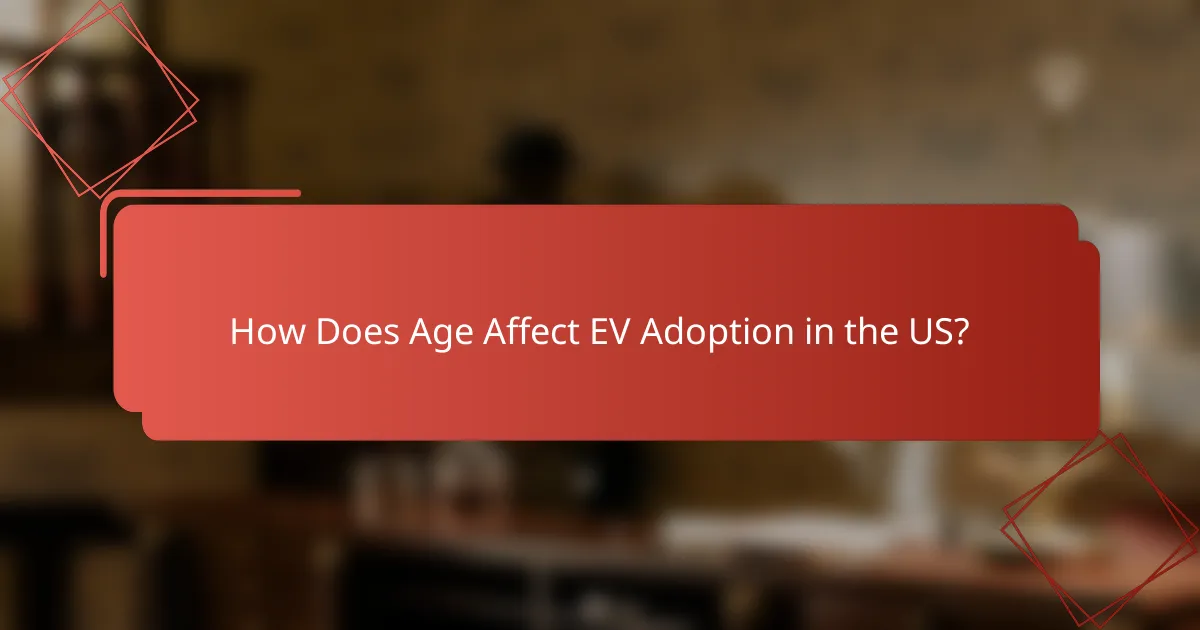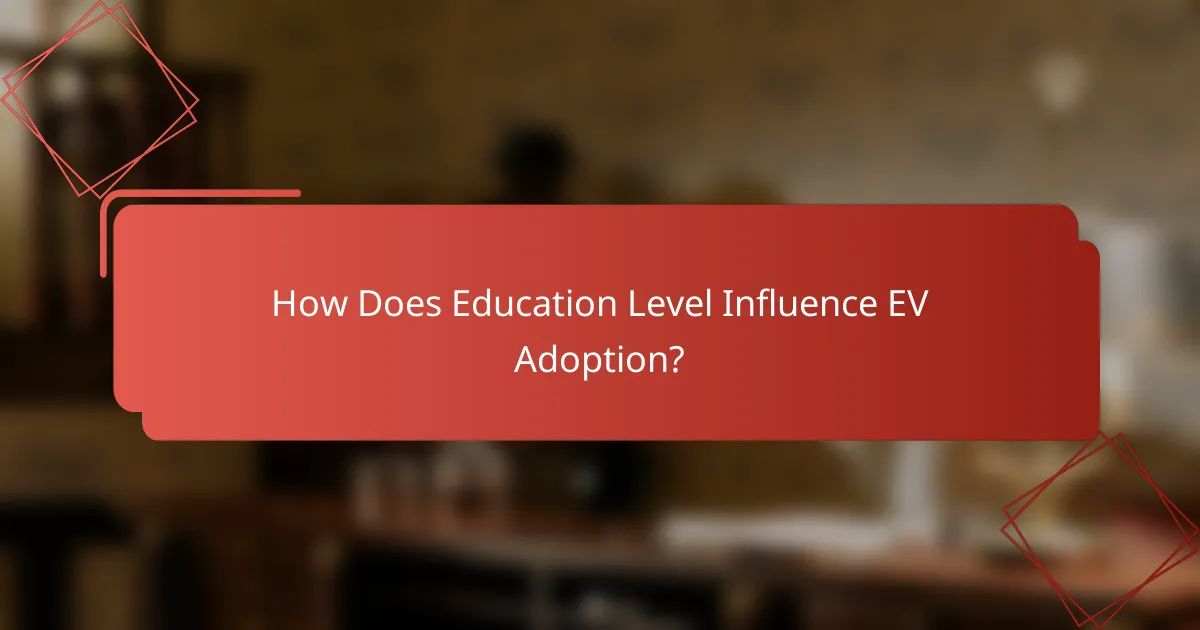Demographic factors such as age, income, and education play a crucial role in the adoption of electric vehicles (EVs). Younger individuals tend to embrace EV technology more readily, influenced by their familiarity with new technologies and environmental concerns. Additionally, higher income levels facilitate EV ownership by enabling consumers to cover the initial costs and necessary infrastructure, while education levels shape awareness and attitudes towards sustainability, further impacting adoption rates.

How Does Age Affect EV Adoption in the US?
Age significantly impacts electric vehicle (EV) adoption in the US, with younger individuals generally showing greater interest and acceptance of EVs compared to older demographics. This trend is influenced by various factors, including technological familiarity, environmental awareness, and financial considerations.
Older adults show lower adoption rates
Older adults tend to adopt EVs at lower rates due to several factors, including limited familiarity with new technologies and concerns about the reliability of electric vehicles. Many in this age group may prioritize traditional vehicles that they perceive as more dependable and easier to maintain.
Additionally, older consumers often have established preferences for specific brands and models, which can hinder their willingness to switch to electric options. Financial considerations, such as the upfront cost of EVs, may also play a significant role in their decision-making process.
Young adults are more likely to adopt EVs
Young adults are generally more inclined to adopt electric vehicles, driven by a combination of environmental consciousness and a preference for innovative technology. This demographic often values sustainability and is more likely to consider the long-term benefits of EV ownership, such as lower operating costs and reduced carbon footprints.
Moreover, younger consumers are typically more comfortable with technology, making them more open to exploring the features and benefits of electric vehicles. Many young adults also seek out EVs as a status symbol, aligning their vehicle choice with their lifestyle and values.
Age-related preferences influence vehicle choice
Age-related preferences significantly influence vehicle choice, with older adults often favoring comfort and familiarity over new technologies. They may prefer larger, traditional vehicles that offer more space and ease of use, while younger consumers might prioritize compact, tech-savvy models that fit their urban lifestyles.
Furthermore, the availability of incentives and subsidies aimed at younger buyers can also sway preferences. Programs that reduce the cost of EVs or provide tax credits are more likely to attract younger consumers who are looking to make environmentally friendly choices without breaking the bank.

What Role Does Income Play in EV Adoption?
Income significantly influences electric vehicle (EV) adoption, as higher income levels often lead to increased ownership rates. Individuals with greater financial resources are more likely to afford the upfront costs associated with EVs, as well as the necessary charging infrastructure.
Higher income correlates with increased EV ownership
Research indicates that higher income households are more inclined to purchase electric vehicles. This trend is largely due to the initial price of EVs, which can be substantially higher than traditional vehicles. For example, many EV models start in the mid to high tens of thousands of dollars, making them more accessible to wealthier consumers.
Additionally, higher income individuals often have the means to invest in home charging stations, further facilitating their transition to electric vehicles. This financial capability creates a positive feedback loop, where increased ownership leads to greater familiarity and acceptance of EV technology.
Income affects charging infrastructure access
Access to charging infrastructure is often tied to income levels, as wealthier neighborhoods typically have more charging stations available. This disparity can create barriers for lower-income households, who may not have the same access to convenient charging options. For instance, urban areas with higher income residents often see more investment in public charging facilities.
Moreover, individuals in lower-income brackets may rely on public charging stations, which can be less accessible or more limited in availability. This lack of infrastructure can deter potential EV buyers who are concerned about charging convenience and range anxiety.
Tax incentives impact low-income households
Tax incentives play a crucial role in making electric vehicles more affordable for low-income households. Programs that offer rebates or tax credits can significantly reduce the effective purchase price of an EV, making it a more viable option for budget-conscious consumers. For example, in the United States, federal tax credits can range from a few thousand dollars to over $7,500, depending on the vehicle model.
However, these incentives may not always benefit low-income households equally, as many tax credits are non-refundable. This means that individuals with lower tax liabilities may not fully utilize these benefits, limiting their ability to purchase EVs. Policymakers need to consider these factors to ensure equitable access to electric vehicles across different income levels.

How Does Education Level Influence EV Adoption?
Education level significantly influences electric vehicle (EV) adoption by shaping awareness, attitudes towards sustainability, and understanding of EV technology. Higher education often correlates with a greater propensity to adopt EVs due to increased knowledge and concern for environmental issues.
Higher education levels lead to greater EV awareness
Individuals with higher education levels typically have better access to information about electric vehicles. They are more likely to engage with research, media, and discussions that highlight the benefits and advancements in EV technology.
This awareness can translate into a greater likelihood of considering an EV as a viable option when purchasing a vehicle. For example, college graduates may be more inclined to explore EV incentives and rebates offered by governments, which can further encourage adoption.
Educated consumers prioritize sustainability
Consumers with higher education often place a stronger emphasis on sustainability and environmental responsibility. They tend to be more informed about climate change and the impact of fossil fuels, which drives their preference for cleaner transportation alternatives like EVs.
This prioritization can lead to a willingness to invest in EVs, even if the upfront costs are higher than traditional vehicles. Many educated consumers view the long-term savings on fuel and maintenance as justifying the initial expense.
Education impacts understanding of EV technology
A higher level of education often equips consumers with a better understanding of the technical aspects of electric vehicles. This includes knowledge about battery life, charging infrastructure, and the overall efficiency of EVs compared to internal combustion engines.
As a result, educated consumers are more likely to feel confident in their ability to navigate the transition to electric vehicles. They can assess the total cost of ownership and make informed decisions about which EV models best meet their needs.

What Are the Interactions Between Age, Income, and Education?
The interactions between age, income, and education significantly influence electric vehicle (EV) adoption. Younger individuals with higher income and education levels tend to adopt EVs more readily, while older demographics may face barriers related to these factors.
Demographic factors create unique adoption profiles
Different age groups exhibit distinct preferences and barriers when it comes to EV adoption. Younger consumers, often more environmentally conscious and tech-savvy, are more likely to embrace EVs. In contrast, older individuals may prioritize traditional vehicles due to familiarity and perceived reliability.
Income levels also play a crucial role; higher earners can more easily afford the upfront costs of EVs, while lower-income groups may find these costs prohibitive. Education influences awareness and understanding of EV benefits, further shaping adoption profiles.
Income and education mitigate age-related barriers
For older consumers, higher income and education can reduce barriers to EV adoption. Educated individuals are more likely to understand the long-term savings associated with EVs, such as lower fuel and maintenance costs. This understanding can encourage them to consider EVs despite their initial hesitations.
Additionally, financial incentives, such as tax credits or rebates, can make EVs more accessible to older adults with higher incomes, enabling them to overcome the financial hurdles that might otherwise deter them from making the switch.
Cross-demographic trends in EV adoption
Recent trends indicate that EV adoption is increasing across various demographics, though the pace varies. Younger, affluent consumers are leading the charge, but older demographics are gradually catching up as awareness grows and technology improves.
Moreover, as more affordable EV models enter the market, adoption rates among lower-income groups are expected to rise. This shift highlights the importance of targeted marketing and education efforts to address the unique concerns of each demographic group.

What Are the Implications for EV Manufacturers?
EV manufacturers must understand demographic factors like age, income, and education to effectively target their marketing and product development strategies. By aligning their approaches with the preferences and needs of different consumer segments, manufacturers can enhance adoption rates and market penetration.
Targeted marketing strategies based on demographics
To effectively reach potential EV buyers, manufacturers should tailor their marketing strategies based on demographic insights. For instance, younger consumers may respond better to digital advertising and social media campaigns, while older demographics might prefer traditional media like television and print.
Income levels also play a crucial role; targeting high-income individuals with luxury EV models can be effective, while offering incentives or financing options may attract middle-income consumers. Understanding these nuances allows for more efficient allocation of marketing resources.
Product development aligned with consumer profiles
Product development should reflect the preferences and needs of different demographic groups. For example, families may prioritize spaciousness and safety features, while tech-savvy younger buyers might look for advanced connectivity and autonomous driving capabilities.
Additionally, education levels can influence the demand for features like sustainability and energy efficiency. Manufacturers should consider incorporating educational elements into their marketing to inform consumers about the environmental benefits of EVs, appealing to eco-conscious buyers.
Partnerships to enhance accessibility for diverse groups
Forming partnerships with local governments, non-profits, and community organizations can enhance accessibility to EVs for diverse demographic groups. These collaborations can help provide charging infrastructure in underserved areas, making EV ownership more feasible.
Moreover, manufacturers can work with financial institutions to create tailored financing solutions that cater to lower-income consumers, helping to overcome economic barriers to EV adoption. Such partnerships can significantly broaden the market reach and foster a more inclusive EV ecosystem.
